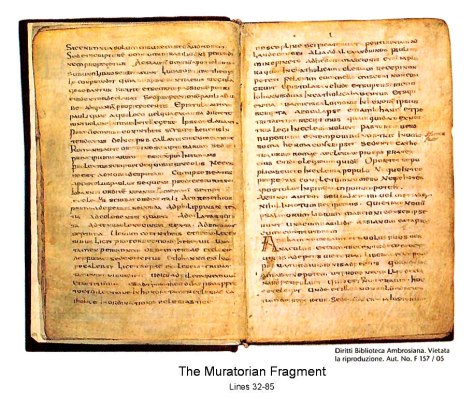
I sometimes hear this odd objection that the books that were to be included in the Bible were not decided until the 4th century. I think it comes from some Hollywood movie, or maybe a TV show. Anyway, this post should help fix that myth.
I’m going to quote from New Testament expert Dr. Michael J. Kruger from his blog.
He writes:
One of the key data points in any discussion of canon is something called the Muratorian fragment (also known as the Muratorian canon). This fragment, named after its discoverer Ludovico Antonio Muratori, contains our earliest list of the books in the New Testament. While the fragment itself dates from the 7th or 8th century, the list it contains was originally written in Greek and dates back to the end of the second century (c.180).
[…]What is noteworthy for our purposes here is that the Muratorian fragment affirms 22 of the 27 books of the New Testament. These include the four Gospels, Acts, all 13 epistles of Paul, Jude, 1 John, 2 John (and possibly 3rd John), and Revelation. This means that at a remarkably early point (end of the second century), the central core of the New Testament canon was already established and in place.
Although there is still dispute about some books, that does not negate the fact that the main books we use (the gospels, Acts, the letters of Paul) are all considered to be canon by 180 A.D., much before any famous church councils ever happened. And those books were decided on because they were in widespread use and respected by everyone.
What about the books that were in dispute? Do they throw any core doctrines into doubt?
Second, if there was a core collection of New Testament books, then the theological trajectory of early Christianity had already been determined prior to the debates about the peripheral books being resolved. So, regardless of the outcome of discussion over books like 2 Peter or James, Christianity’s core doctrines of the person of Christ, the work of Christ, the means of salvation, etc., were already in place and already established. The acceptance or rejection of books like 2 Peter would not change that fact.
By the way, I’d actually heard that the date for this fragment was 170 A.D., so it might even be earlier than Dr. Krueger says.
I did search around a bit for something to break the tie between me and Krueger, because I couldn’t remember my source for the date. I found this book “Jesus, Gospel Tradition and Paul in the Context of Jewish and Greco-Roman Antiquity” by David E. Aune, and he writes on p. 22:
The four Gospels are also referred to in the Canon Muratorianus, a seventh or eighth century manuscript originally translated from Greek into a deponent form of Latin and widely regarded as having been produced ca. 170 CE. Though the beginning of this canonical list is fragmentary (though obviously referring to Mark), the first two clear references to New Testament books are to Luke and John (lines 2, 9): tertio euangelii librum secando Lucan guard evangeliorutn lohannis ex decipolis.” (“The third book of the Gospel is that according to Luke … The fourth of the Gospels is that of John, [one) of the disciples”).
So, that’s why the date in the title of this post is 170 A.D., and not the later 180 A.D. he mentions. And that’s why there’s no reason to be skeptical that the Bible we have today is any different than the Bible that everybody in the early church had.

It’s likely that Origen advocates the same twenty-seven-book canon we have today around the middle of the third century:
http://triablogue.blogspot.com/2009/05/twenty-seven-book-new-testament-before.html
Furthermore, Augustine suggests that the Donatists held that same canon in the early fourth century. When Athanasius cites that canon in the middle of the fourth century, he refers to it as if it’s already accepted to a significant extent. It’s not something new.
Tertullian, a contemporary of the Muratorian Canon, includes even more of our New Testament books than the Muratorian Canon does. Here’s a post in which I argue that each of the twenty-seven books probably was accepted by a majority in the ante-Nicene era:
http://triablogue.blogspot.com/2009/05/significance-of-other-new-testament.html
LikeLike
Whatever a respected church father Tertullian quotes as Scripture is a helpful indicator of what counted as Scripture, and that’s second century – much earlier than the 4th century conspiracy theory view.
LikeLike
We know that faith is the substance of things hoped for..but when something as concrete as this turns up it gives me anyway a thrill in my heart
LikeLike
Speaking of faith. Did you know that the Roman Church would not admit the canonicity of the Book of Hebrews for 400 years?
LikeLike